How the miraculous heroes of A. V. Suvorov took the "fortress without weak spots"
A.V. Suvorov
Vesuvius flames spew,
The pillar of fire is in darkness,
The crimson glow gapes
Smoke black club flies up.
Pale Pont, roar thunder
The blows are followed by thumps,
The earth trembles, the rain of sparks flows,
Rivers of rydnya lava, -
Oh, Ross! This is your image of glory,
That matured under Ishmael light.
G. Derzhavin. "Ode to the capture of Ishmael"
December 24 celebrates the Day of Military Glory of Russia - the Day of the capture of the Turkish fortress Izmail. 11 (22) December 1790, the Russian troops under the command of the great commander Alexander Suvorov stormed the key Turkish fortress Ishmael, which the enemy considered "impregnable".
On the south side of the fortress defended the Danube. The fortress was built under the leadership of French engineers in accordance with the latest requirements of the fortification and the Turks said: "Rather, the sky will collapse on the ground, and the Danube will flow upwards than Izmail surrenders." However, Russian troops have repeatedly denied the myths about the "inaccessibility" of various fortresses and positions. Interestingly, Ishmael was taken by the army, inferior in strength to the garrison of the fortress. The case is extremely rare in stories military art.
The inaccuracy in the date of military glory is due to the fact that the dates of most of the battles that took place before the introduction of the Gregorian calendar in Russia in 1918 were obtained by adding the 13 days to the “old age” date, that is, the difference between the new and old age dates, which they had in the twentieth century. The difference between the old and the new style in 13 days accumulated only by the XX century. In the XVII century, the difference was 10 days, in the XVIII - 11 days, in the XIX - 12 days. Therefore, in historical science adopted other dates of these events, rather than in this law.
Storm of Ishmael, engraving of the XVIII century
prehistory
Not wanting to come to terms with the results of the Russian-Turkish war 1768 — 1774, instigated by England and Prussia, Turkey in July 1787 ultimately demanded from Russia that the newly acquired Crimea return, abandon the protection of Georgia and agree to inspect the Russian merchant ships passing through the straits . Not having received a satisfactory answer, the Turkish government 12 (23) August 1787 declared war on Russia. The main goal of Porta was to capture the Crimea. For this, the Ottomans had strong instruments: a fleet with a large assault force and the garrison of Ochakov.
In an effort to use their advantageous position, the Ottomans showed great activity at sea, and in October they landed troops on the Kinburn Spit to seize the mouth of the Dnieper, but Russian troops under the command of AV Suvorov destroyed the enemy troops. In the winter of 1787-1788. Two armies were formed: Ekaterinoslav Potemkin and Ukrainian Rumyantsev. Potemkin was to advance from the Dnieper through the Bug and the Dniester to the Danube and take the enemy's strong fortresses - Ochakov and Bender. Rumyantsev in Podolia was supposed to reach the middle course of the Dniester, keeping in touch with the Austrian allies. The Austrian army was located near the borders of Serbia, and the auxiliary corps of the Prince of Coburg was sent to Moldova to communicate with the Russians.
The 1788 campaign of the year as a whole did not bring an ally of decisive success. The Austrian army suffered a complete defeat in Wallachia. Potemkin only in June crossed the Bug and in July besieged Ochakov. He acted sluggishly, 80 thousand. Russian army for five months stood at the Turkish fortress, which defended all 15 thousand Turks. Only in December, the army, tired of disease and cold, took Ochakov. After that, Potemkin took the army to the winter apartments. Prince of Coburg, in vain besieged Khotyn. Rumyantsev sent the Saltykov division to his aid. The Turks, who did not want to surrender to the Austrians, who were despised, surrendered to the Russians. Rumyantsev occupied northern Moldova, setting up troops in the Yassy-Chisinau area for winter.
The 1789 campaign of the year was more successful. Potemkin with the main army was planning to take Bender, and Rumyantsev with less forces had to go to the Lower Danube, where the Vizier with the main Turkish army was located. In the spring, three Turkish detachments (about 40 thousand people in total) moved to Moldova. Prince of Coburg, hastily retreated before the superior forces of the enemy. Rumyantsev threw the division of Derfelden to help the allies. General Vilim Dörfelden dispersed all three Turkish troops. This was the last success of the army of Rumyantsev. They took the army from him and formed a unified Southern army under the command of Potemkin, which slowly moved towards Bender.
The Grand Vizier Yusuf, having learned about the movement of the army of Potemkin, decided to defeat the Austrians in Moldova before the arrival of the main Russian forces. Against the weak corps of the Prince of Coburg, Osman Pasha’s strong corps was moved. But Alexander Suvorov with his division saved an ally. 21 July 1789 year Russian-Austrian troops under the general command of Suvorov defeated the Ottomans under Focsani. Meanwhile, Potemkin laid siege to Bender, but again acted passively, and pulled almost all the available troops to him. In Moldova there was only one weak division of Suvorov.
The Ottoman command, having learned about the weak forces of the Russians and the Austrians, and their separate positions, decided to smash the units of Coburg and Suvorov. And then go to the rescue Bender. 100 thousand. Turkish army moved to the river Rymnik to defeat the Austrians. But Suvorov saved the Allies again. September 11 in the battle of Rymnik Russian-Austrian troops under the command of Suvorov utterly defeated the enemy's hordes. The Turkish army simply ceased to exist. The victory was so decisive that the Allies could calmly force the Danube and end the war with a triumphal march on the Balkans. However, Potemkin did not use this brilliant victory and did not leave the siege of Bender. In November, Bender took and on this campaign ended. The Austrians in this campaign were inactive until September, then they crossed the Danube and captured Belgrade. A detachment of Coburg after Ramnik occupied Wallachia.
Thus, despite the brilliant victories of the Russian army, Turkey refused to put up, using the sluggishness of the supreme Russian command. Delaying the time, Porta formed an alliance with Prussia, which exposed the 200 thousand army on the Russian and Austrian borders. Nuscan Prussia and England, Sultan Selim III decided to continue the war.
The 1790 campaign of the year began unsuccessfully for Russia. The military-political alignment was not in favor of Russia. Worried Poland. The war continued with Sweden. In February 1790 of the year died Austrian Caesar Joseph II. His successor, Leopold II, fearing that the continuation of the war with Turkey would lead to conflict with Prussia, began peace negotiations. In addition, the Austrian army was defeated. Austria has concluded a separate peace. However, Catherine II was a tough man, the threats of Prussia and the "flexible" policy of Austria did not act on her. Taking measures in case of war with Prussia, Catherine demanded decisive action from Potemkin. But the Most Serene Prince, in his custom, was in no hurry, and all summer and autumn was inactive. A talented politician, courtier and manager, Potemkin was not a real commander. He was torn between the theater of military operations and the court in St. Petersburg, fearing to lose his former influence.
The Turks, having escaped from Austria, returned to their original plan of war. On the Danube they defended themselves, relying on the first-class fortress Izmail, and turned their full attention to the Crimea and the Kuban. Using strong fleet the Turks wanted to land a large landing and raise mountain tribes and Crimean Tatars against the Russians. However, the Russian fleet, under the command of Fyodor Ushakov, buried all the enemy’s plans in the battle at the Kerch Strait (July 1790) and the island of Tendra (September 1790). The 40th Batal Pasha army that landed at Anapa, which had the goal of going to Kabarda, was defeated in September by the corps of General Gudovich in the Kuban. Later, on June 22, 1791, the commander of the Kuban and Caucasian corps, Ivan Gudovich, took the "Caucasian Ishmael" - the first-class Turkish fortress Anapa. The fortress, built under the guidance of French engineers, was the base of Turkey in the North Caucasus and a strategic base for operations against Russia in the Kuban and Don, as well as against the Crimea. Therefore, it was a strong blow to the Ottoman Empire.
Thus, the attempts of the Turks to land troops in the Caucasus and the Crimea and to achieve dominance at sea were stopped by the Black Sea Fleet under the command of Ushakov and Gudovich’s corps. The Ottomans' offensive strategy failed.
Ishmael
Only in late October, the army of Potemkin launched an offensive and moved into southern Bessarabia. Russian troops captured Kiliya, Isakchey, Tulcha. A detachment of Gudovich Junior and Pavel Potyomkin’s brother laid siege to Ishmael. But the Russian troops could not take Ishmael, the siege was delayed. It was captured the island Chatal, located against the fortress. This landing operation was carried out boldly and resolutely by Major General N. D. Arsenyev. He also installed artillery batteries on Chatal. During the preparation of the assault, they bombarded the inside of the fortress.
Ishmael was a powerful fortress on the left bank of the Danube. According to Turkish military terminology, it was called "Horde-Kalesi", that is, "Army fortress" - the fortress of the collection of troops. Ishmael was able to accommodate an entire army, which is what happened. The remnants of the Ottoman garrisons escaped here from the already fallen fortresses. The fortress was rebuilt by French and German engineers according to the latest requirements of serf art (works were carried out from the 1774 year).
Izmail fortress consisted of two parts - the larger western Old Fortress and the eastern New Fortress. The main fortification shaft of 6-6,5 km long girdled the city from three sides. The south side was protected by the river. The height of the shaft, which was distinguished by a large steepness, reached 6-8 m. In front of them stretched a ditch with a width of 12 m and a depth of 10 m. In some of its places there was water to a depth of 2 m. Before the moat were arranged "wolf holes" and all sorts of traps for attackers . On 11 bastions, mostly earthen, there were 260 guns. But the height of the bastions reached 20-24 meters. In the southwestern corner of the fortress stood the stone tower of Tabiya with a three-tier cannon battery. From the tower to the river bank there are shelves and a strong palisade of pointed logs. In the north was the most powerful defense, in this direction, Ishmael was protected by a fortress fortress. Here was located the Bendery bastion, dressed in stone. To the west of the citadel was the Lake of Casting, the marshland from which approached the moat, which worsened the capabilities of the attackers on the assault. From the side of the Danube, the fortress had no bastions, initially hoping for protection from the Danube Flotilla. However, it was almost destroyed, so the Turks built batteries with large-caliber guns, which allowed the shelling of the river and the field fortifications of the Russian troops on the island of Chatal lying against Ismail. They were reinforced with small-caliber artillery, which they saved from dead ships. In total, the coastal part of the fortress was covered by about a hundred guns. The fortress had well-protected gates: from the west - Tsargrad and Khotyn, from the east - Kiliya and from the north - Bender. The approaches and the roads to them were covered with flanking artillery fire, the gates themselves barricaded.
The fortress defended 35-40 thousand garrison led by Mehmet Pasha. Almost half of the troops were selected infantry - Janissaries. The rest were sipahi - light Turkish cavalry, artillerymen, armed citizens-militiamen. Also, detachments from the previously defeated Turkish garrisons and crews from the ships of the Danube military flotilla sunk from Izmail flew into the fortress. The Turks were supported by the Crimean Tatars under the command of Kaplan-Girey. The Sultan was very angry with his troops for all the previous surrenders and ordered to stand to the last, commanding in the event of the fall of Ishmael to execute everyone from his garrison, wherever he was found. In addition, the fortress had large reserves and could long be under siege.
Engraving by S. Shiflyar "The Storm of Ishmael 11 (22) December 1790."
As a result, the military council of the commanders of the troops assembled under Izmail decided to lift the siege. Winter was approaching, the soldiers were sick, froze (there was no firewood), which led to great sanitary losses. There was no siege artillery, and field guns were experiencing a shortage of ammunition. Morale troops dropped.
Then Potemkin, who attached special importance to the capture of Ishmael, hoping to incline Porto to peace, entrusted the siege to Suvorov, telling him to decide whether to take the fortress or retreat. In fact, Alexander Vasilyevich was ordered to do what other generals could not, or retreat, to drop their prestige. Taking with him his miracle warriors from the Apsheron and Fanagori regiments, Alexander Vasilyevich hurried to Ishmael. He met already retreating troops and returned them to the trenches. The arrival of the victorious general inspired the soldiers. They said: “Storm! It will be, brothers, assault, once Suvorov himself flew in ... ”
Suvorov, despite all the problems of the Russian troops and the superiority of the forces of the enemy, who sat behind strong fortifications, spoke in favor of the assault and began to actively prepare for it. He understood that the operation would be extremely difficult. In his letter to Potemkin, the general wrote: "A fortress without weak points." Alexander Vasilievich will later say that such an assault can be “launched only once in a lifetime.” The new commander ordered the manufacture of assault ladders and fascins to fill the moat. The main attention was paid to the training of troops. Next to his camp, Suvorov ordered to dig a ditch and fill the shaft in the manner of Izmail. Stuffed on the shaft depicted Turk. Every night the troops were trained in the actions necessary during the assault. The troops learned to storm the fortress: having overcome the moat and the rampart, the soldiers pricked stuffed bayonets.
Suvorov had a regular infantry 33 battalion (14,5 thousand people), 8 thousand dismounted Don Cossacks, 4 thousand Black Cossacks (mostly former Zaporozhian) with a rowing fleet, 2 thousand arnauts (volunteers) - Moldovans and Valahs 11XXXXX. and 4 Don Cossack regiment. Total 31 thousand people (28,5 thousand infantry and 2,5 thousand cavalry). As a result, a significant part of the troops of Suvorov were Cossacks, most of whom lost horses and armed mostly with cold weaponspeaks. Suvorov had a lot of guns - several hundred, including a rowing flotilla. But there was almost no heavy artillery, and the existing guns could not cause any serious damage to the enemy fortress. In addition, as Suvorov himself wrote in the report: "Field artillery has only one set of shells."
Having finished the assault preparation on 6 days, Suvorov 7 (18) December 1790 sent the commandant Ishmael an ultimatum demanding to surrender the fortress no later than 24 hours after the ultimatum was handed. “Seraskir, foremen and all of society. I arrived with the troops here. 24 hours to think about - the will. My first shot is already bondage, the assault is death, which I leave to you to think about. ” Ultimatum was rejected. Mehmet Pasha, confident of the inaccessibility of his fortifications, replied arrogantly that the sky would rather fall to the ground and the Danube would flow backwards than Ishmael would fall.
On December 9, the military council assembled by Suvorov decided to immediately proceed to the assault, which was assigned to December 11 (22). According to the “Military Regulations” of Tsar Peter the Great, according to Peter’s tradition, the right to be the first to speak at the military council was given to the youngest by age and rank. That was the foreman Matvey Platov, in the future the most famous Cossack ataman. He said: "Storm!"
Assault
The 10 (21) of December, with the rising of the sun, began artillery preparation for storming fire from flank batteries, from the island and from ships of the flotilla (there were a total of about 600 guns). It lasted almost a day and ended 2,5 hours before the start of the assault. With the beginning of the assault, the artillery went to firing with “empty shots,” that is, idle charges, so as not to hit their attackers and frighten the enemy.
Before the storming, Suvorov addressed the troops with the words: “Brave warriors! Bring to your memory today all our victories and prove that nothing can resist the strength of the Russian weapon ... Two times the Russian army besieged Ishmael and twice retreated; it remains for us a third time to either conquer or die with glory. ”
Suvorov decided to storm the fortress in all places, including from the river. The attacking troops were divided into 3 squad of 3 columns each. A detachment of Major-General de Ribas (9 thousand people) attacked from the side of the river. The right wing under the command of Lieutenant-General P. S. Potemkin (7,5 thousand) was to strike from the western part of the fortress. The left wing of Lieutenant-General A. N. Samoilov (12 thousand people) came from the east. Cavalry reserve brigadier Westfalen (2,5 thousand people) was waiting for the moment when the gate was opened. Suvorov decided to launch an assault on 5 in the morning, approximately 2 hours before dawn. Darkness was needed for the suddenness of the first blow, forcing the moat and grabbing the shaft. In front of each of the columns were specially selected arrows to defeat the defenders of the bastions and the shaft. Workers' teams also moved ahead: they carried axes and other assault stairs. They had to pave the way through palisades and other obstacles.
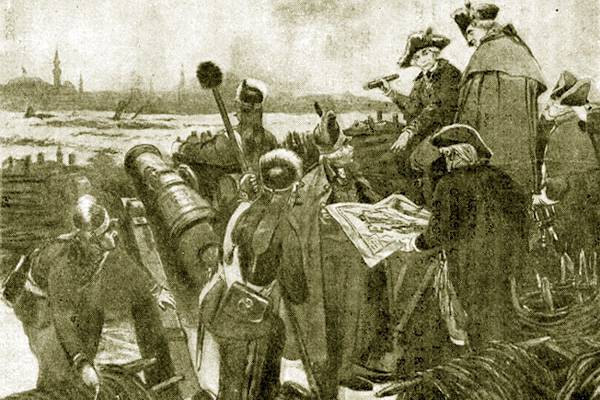
Suvorov and Kutuzov before the assault of Ishmael. Artist O. Vereisky
The assault did not surprise the enemy. They were waiting for an attack from Suvorov. In addition, several defectors revealed to them the day the operations began. However, this did not stop the Russian soldiers. The first in 6 hours of the morning were climbed on the shaft of the enemy fortress of a huntsman from General Xass's 2 column (Potemkin’s right wing). They, beating off the fierce attacks of the Janissaries, captured an important strong point of the enemy - the Tabiya tower. The grenadiers of the Fanagoria regiment of Colonel Vasily Zolotukhin, who captured and opened for the cavalry Tsargrad (Brossky) gates, became the heroes of taking Tabiya.
Next, the Absheron shooters and the Fanagorian grenadiers of the 1 st columns of General Lvov captured the Khotyn gates and connected with the soldiers of the 2 st column. They opened the gates of the fortress for the cavalry. The greatest difficulties fell to the 3 column of General Meknob. She attacked part of the northern bastion, where the depth of the moat and the height of the shaft were so great that the assault stairs in 11 meters were short. They had to be tied together under fire by two. As a result, the soldiers broke into the enemy stronghold.
Heavy battle had to lead 6-th column of General Mikhail Kutuzov (left wing of Samoilov). She was storming around the New Fortress. Kutuzov's column could not break through the dense fire of the enemy and lay down. This took advantage of the Turks, who went on the counter. Then Suvorov sent Kutuzov an order appointing him as commander Ishmael. Encouraged by the confidence, the general personally carried the infantry to the attack and, after a fierce battle, broke into the fortress. Our troops captured the bastion at the Kiliya gates. The 4-I and 5-I columns, respectively, of Colonel V. P. Orlov and brigadier M. I. Platov, also carried out the tasks assigned to them, defeating the ramparts in their sections.
While some troops stormed the rampart, soldiers under the command of General de Ribas landed in the city from the side of the river. Attack of the troops of Ribas was promoted by a column of Lviv, which captured coastal Turkish batteries on the flank. With the rising of the sun, the Russian soldiers had already fought on the walls of the fortress, seized the towers, gates and began to push the enemy inside the city. Street battles also differed fierce, almost no prisoners were taken.
The Ottomans did not give up and continued to fight hard, relying on the numerous stone structures inside the fortress (private stone houses, mosques, commercial buildings, etc.), which were used as separate bastions and prepared for defense in advance. The Turks fought desperately, counterattacked. Almost every house had to be taken by storm. Suvorov threw into the city all of the forces, including 20 light guns, which are very useful. We used to clear the streets of defenders and counterattacking Turks and Crimean Tatars by stripping the roads, making our way forward, knocking out the gates. By two o'clock, the Russians, having beaten off several fierce counterattacks of large Turkish troops, finally made their way into the city center. By 4 hours the battle is over. The remnants of the Turkish garrison, wounded and exhausted, laid down their arms. Ishmael fell. It was one of the most brutal battles of this war.
That same evening 11 (22) of December Suvorov briefly reported on the capture of the Turkish stronghold on the Danube to commander-in-chief Field Marshal G.A. Potemkin-Tavricheskogo: “There is no stronger fortress, no more desperate than defense, as Ishmael, fallen before the highest throne of her imperial majesty by a bloody assault! I congratulate your ladyship! General Count Suvorov-Rymniki ".
The assault of Ishmael. Diorama. Artists V. Siberian and E. Danilevsky
Results
The Turkish garrison ceased to exist, the battle was extremely fierce: some killed were more than 26 thousand people (the city was cleared of corpses for several days). 9 of thousands were taken prisoner, many of whom died from wounds. According to others, the Turks lost 40 thousand people, including all senior commanders. Our troops seized a huge booty: around 260 guns, a large number of ammunition, more 300 banners and badges, ships of the Turkish Danube Flotilla and many trophies inherited by the army, totaling up to 10 million piastres (over 1 million rubles). The loss of our troops amounted to about 4600 people.
The assault of Ishmael was an outstanding feat of Russian soldiers. In his report, Alexander Vasilyevich noted: "It is impossible to extol quite praise for the courage, firmness and bravery of all the ranks and all the troops that worked in this matter." In honor of the victory for the officers participating in the assault, a special golden cross was issued “For excellent courage”, and the lower ranks received a special silver medal with the inscription “For excellent courage when taking Ishmael”.
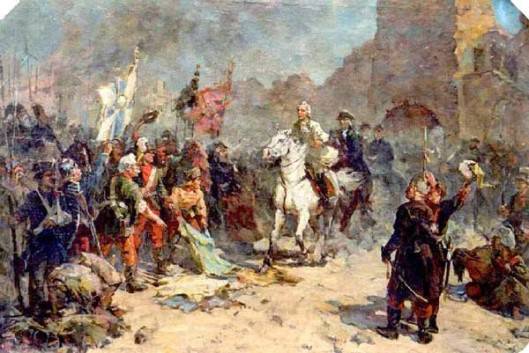
Painting of the artist A.V.Rusin "AVSuvorov's Entrance to Izmail". Job written in 1953 year
Strategically, the fall of Ishmael did not have the desired effect on Istanbul. Encouraged by England and Prussia, the sultan continued to persist. Only the course of the 1791 campaign of the year, when the Russian army under the command of Nikolay Repnin defeated the enemy in several battles (in these battles M. Kutuzov especially distinguished) and the defeat of the Ottoman fleet in Kaliakria from the Russian squadron F. Ushakov, forced the sultan to seek peace.
Interestingly, the victory for Suvorov turned into light disgrace. Alexander Vasilyevich was counting on getting Ishmael to receive the rank of field marshal, but Potemkin, applying for his award to the empress, offered to award him with a medal and rank of guard lieutenant colonel. The medal was knocked out, and Suvorov was appointed lieutenant colonel of the Preobrazhensky regiment. There were already ten such lieutenant colonels, and Suvorov became the eleventh. These awards seemed contemporaries ridiculous compared with the victory and the “golden rain” that hit Potemkin. The commander-in-chief of the Russian army, Prince Potemkin-Tavrichesky, having arrived in St. Petersburg, received as an award the field marshal's uniform embroidered in diamonds, priced at 200 thousand rubles, the Tauride Palace. In Tsarskoye Selo it was planned to build an obelisk for the prince with the image of his victories and conquests. But Suvorov was removed from the troops (his unsociable, independent character, contempt for the palace order irritated Potemkin), and ended the war without the best Russian commander at the time. Suvorov was soon “banished” to inspect all the fortifications in Finland. Not the best solution, given the talents of the commander.
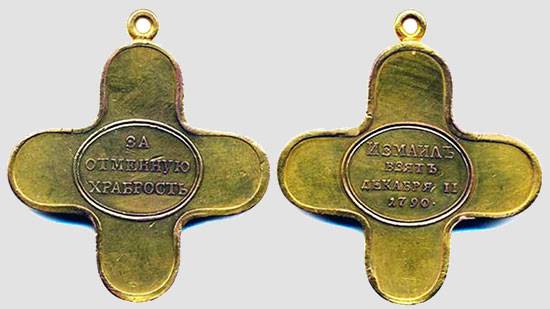
Golden award cross for officers participating in the assault on Ishmael
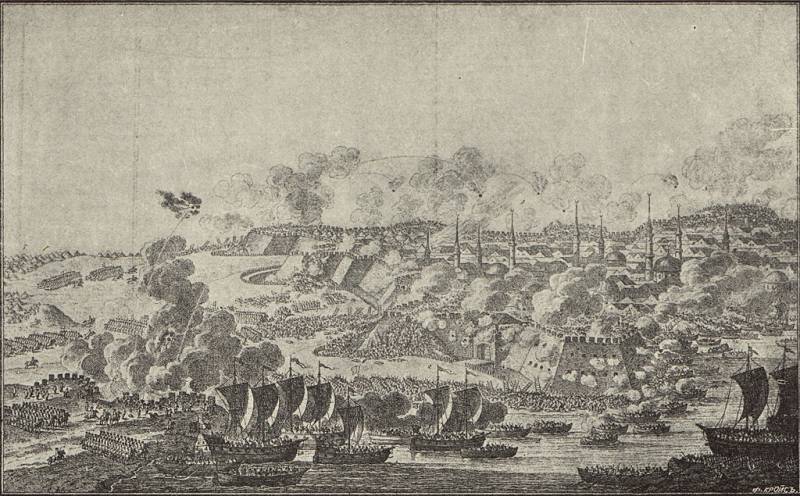
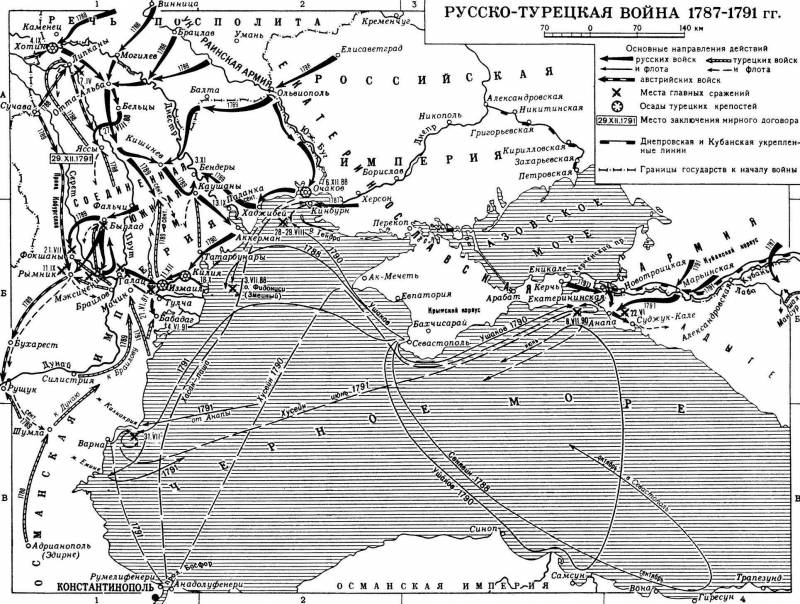
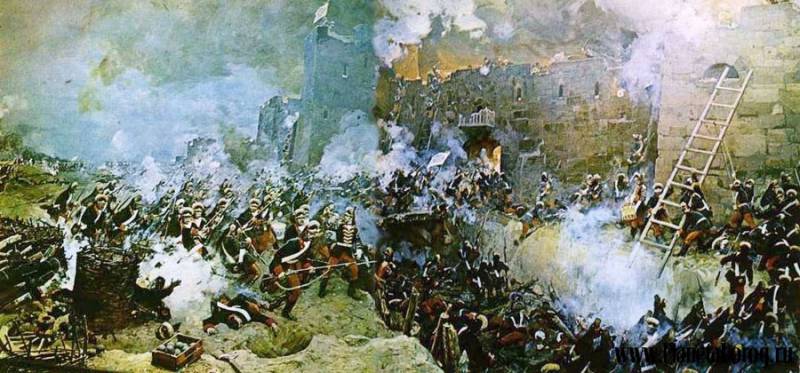
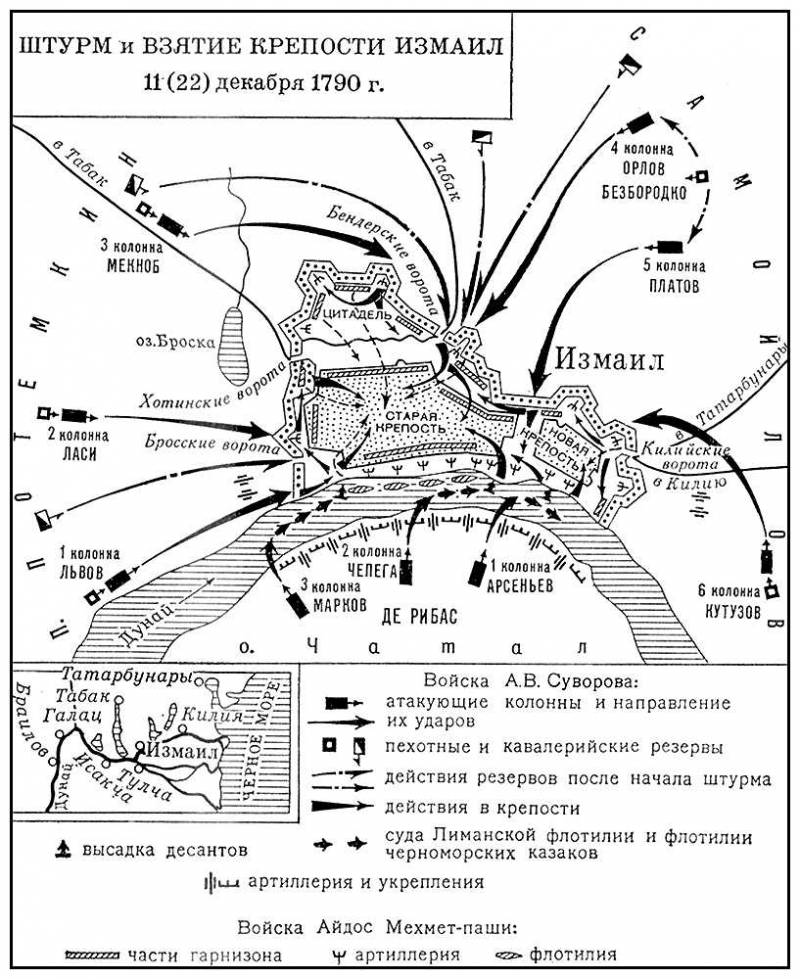
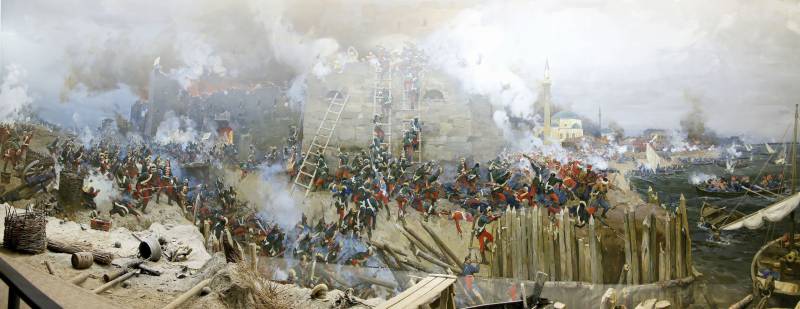
Information